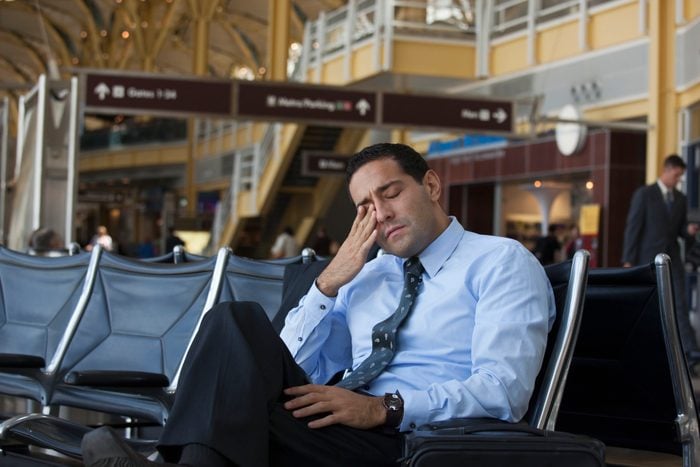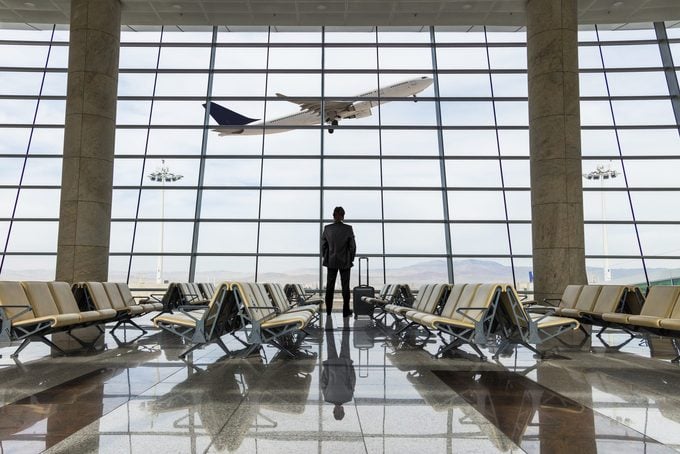Can You Leave the Airport During a Layover?
Updated: Sep. 08, 2023

A long layover is an opportunity to get a glimpse of a new city, but it can be a gamble. Here's what you need to consider before leaving an airport between flights.
Great adventures often come from unexpected opportunities, and when it comes to travel, one of those is the layover. That’s right—that seeming annoyance when you’re booking your holiday travel and you can’t get a direct flight can actually be a good thing. If you’re not in a rush, a layover can give you a little glimpse of a city you may have never seen or a chance to catch up with old friends. But these mini pit stops aren’t all the same, and you can’t always take advantage of them. So, when can you leave the airport during a layover?
It really depends, because time is of the essence. Not every airport provides easy layover options, and you also need to take into account the stress that may result when things go wrong and you’re in danger of missing your next flight. Remember: Stay flexible with your layover plans, because a changed itinerary or canceled flight could completely upend them.
On This Page
What is a layover?
When your journey includes a combination of flights through connecting airports, that time you spend at the in-between airports is a layover or a stopover, depending on the time between the two flights. “Standard layovers are usually up to four hours on domestic flights and up to 24 hours on international flights,” explains William J. McGee, Senior Fellow for Aviation at the American Economic Liberties Project, noting that they are most common at hub airports. “Destinations that have very few nonstop flights are usually small and/or rural cities, with little passenger traffic, so the hub system allows connections to a broader range of destinations. ‘Stopovers’ are lengthier, usually more than four hours.”
Say you’re off to that dream safari in Kenya from upstate New York. You’d likely fly from Buffalo to JFK in New York City, then to one of London’s six international airports, or maybe Paris. Another flight would take you to Lagos, Nigeria, and then you’d hop another flight to Nairobi. Each of those layovers may be hours, or even a day or two, apart. Usually, layovers are less exotic and last anywhere from less than an hour to a few hours.
Why do layovers exist?
Layovers make flying affordable for both customers and airlines. Using the “hub-and-spoke” system allows airlines to create a budget-friendly means of ferrying customers between major destinations, where they will transfer to connecting flights for their end destinations. Smaller cities just don’t get enough passengers for larger, direct flights from distant destinations, and high fuel prices pose an added problem. Instead, smaller cities tend to be serviced by regional carriers with shorter flights from hub airports, under partnerships with the originating airline. This is common in Mexico, where international travelers often land in Mexico City before taking flights to León, Mérida, or any dozens of other smaller airports throughout Mexico.
While it can be a hassle to have to change to a connecting flight, they have helped to make travel much more affordable in recent decades. The reasons why can include everything from fuel economy to airlines paying lower airport fees in places like Frankfurt. For international flights, such as, say, New York to Delhi, you could find a direct flight that gets you there in 17 hours, or you might take connections that unfold over 54 hours. The difference in price could be considerable.
Back in the day, layovers were also a necessity for planes that needed to refuel or be serviced, but that’s no longer the case. “This has become unusual with the advent of ultra long-haul aircraft. With scattered exceptions, almost any two major cities in the world can now be connected nonstop,” explains Ask the Pilot’s Patrick Smith. “Today, it’s less of a technological challenge than one of simple human endurance.”
Can you leave the airport during a layover?

In theory, absolutely! In practice, whether you leave the airport during a layover is tricky. If you’re traveling domestically, you won’t have to worry about customs or visas, but you’re still leaving the airport, and returning gives you zero priorities over other passengers who are checking in on that flight. You’ll have to check in and go through security. Plus, you may have to collect your bags between flights, which means you’ll need to find out whether the airport has luggage storage, as not all do. Sometimes, you can check your bag for the next flight, then leave the airport during your layover, but it depends—every airport and airline is different.
Internationally, there are visa and customs concerns to contend with. Every new airport in a new country may require you pass customs both to leave the airport and to reenter it. They may even require a visa, which might need to be applied for and paid in advance. Again, it depends on the airport and airline, which is why McGee cautions travelers to do their research. At a bare minimum, you’ll always need to check in for your flight and go through security whenever you leave the airport and come back for the next leg of your trip.
Layovers are regulated by the Federal Aviation Administration (FAA), but leaving the airport between flights is a risk you take, and if you miss your flight, it’s on you. The airline could give you a break, but they are not required to do so.
How long does a layover need to be to leave the airport?
Because layovers are your choice, you can leave whenever you like, but seasoned travelers, including McGee, seldom leave airports for less than six hours. After all, airports themselves aren’t usually in bustling, interesting areas. You’ll need to get to where you want to be, and that’s the catch—you’ll need to account for the time to your destination and then back to the airport. Urban trains tend to be the most reliable transportation, but it’s still usually at least a 30-minute trip to the city center, like in Madrid. Then there’s whatever you’ve got on your agenda—places to visit, dining, sightseeing, and beyond.
But what if something goes awry? Travel to and from the airport eats up time and comes with risks, especially on holidays. Buses may not be on time, cabs can get stuck in traffic, and if there’s a road race, construction, or a protest disrupting traffic, you might find that your “fun” trip out of the airport isn’t all that fun at all.
Frequent traveler Ann Woodward, who’s made her way through 78 countries in the last 11 years, loves layovers in New York because it gives her the opportunity to catch up with a friend or two. But even with an intimate knowledge of the city and the transit system, she prefers to do that with a layover in the 10- to 11-hour range. “I always allow a ton of time for travel and check-in,” she says. Plus, she doesn’t sightsee on her way to seeing people and doing things. “There are people who linger and dawdle, and I am not one of them.” The rule of thumb is to always assume things will go wrong.
What can you do when you leave the airport during a layover?
Really, anything, but it’s smart to skip anything busy or with long lines. What you can do during a layover will change from city to city, depending on available transportation. But when airports are serviced by subways and trains, they’re the safest for layover plans. Madrid, for example, is a wonderful city for layovers, with a speedy 30-minute train into town, perfect for strolling through the heart of the city for a walking tour. Think museums, architecture, hiring a tour guide, or seeing a long-lost friend for a drink in a beautiful location that maybe only locals know.
On a recent 10-hour New York layover, Woodward took the AirTrain from JFK, then an E-Train to 74th Street in Jackson Heights. The plan? Eat her way through Queens with friends. An ambitious culinary tour was possible with the four to five hours spent in Queens (about 12 miles away), with five hours left for check-in and travel. “I crafted a late lunch of momos at a Himalayan restaurant, followed by Colombian empanadas and pudding from an Asian bakery,” she says. Also on tap was a visit to an Indian grocery shop for special chili flakes for her friend she’d soon see in Europe.
Do you have to go through security again to make a connecting flight?
If you’re flying in and rushing off to your connecting flight, you usually won’t have to go through security again, since you’re not leaving a secure part of the terminal. However, some huge airports, like JFK, London’s Heathrow, or Rome’s Leonardo Da Vinci Airport, may require changing terminals for your flight, and in that case, another security gate is likely.
Either way, airlines account for that time between your connections, but you need to find out exactly how much time you have when buying plane tickets or checking in for your initial flight. Feel free to ask flight staff about the airport at the gate or even on the plane; often, they can help you anticipate how swiftly you can get to your next flight’s gate or even arrange accommodations to get you there on time.
If you leave the airport for your layover between the flights, you’ll absolutely have to go through security again. That’s because you’ll have left the TSA-secured part of the terminal, and you might have picked up food you’re not allowed to bring on the plane—or, worse, something illicit or dangerous. This rule ensures everyone’s safety.
What do you do with luggage if you leave the airport during a layover?
On flights with layovers, your luggage will usually be transferred between the flights, so you only need to deal with your carry-on during the layover. However, you should confirm this with the check-in desk or call the airline beforehand.
Before 9/11, folks could use lockers at most airports around the world, but that’s not an option today. “Due to security concerns, most airports no longer allow any type of lockers or baggage storage,” says McGee. “However, depending on the airline, the airport, and the country, you may be able to have your baggage checked through to your destination. Rules vary on this. You may need to claim your baggage and recheck it between flights, so check with the airline in advance.”
But there are third-party companies, like Excess Baggage, that offer in-terminal luggage storage at airports around the world. Usually, a search on the airport’s official website for “luggage storage” or “storage lockers” can tell you if your layover airport works with companies that offer storage between flights. The big thing to keep in mind: Like most things with flying, things vary widely between airports, cities, and nations, so you’ll need to research your options in advance.
What happens if I miss my connecting flight?
There’s the rub, adventurer. While airlines are supposed to ensure that you have time to reach your connecting flight’s gate during super-short layovers, there are no such allowances for passengers who choose to leave the airport on a layover. If you gamble on leaving the airport and don’t make it back in time to catch your flight, you’re probably out of luck. You need sufficient time to check in for the flight, go through security (and possibly customs) again, perhaps provide COVID documentation, and then get to the gate. Being on a layover does not give you priority reentry over anyone.
And here’s another bit of unfortunate news: It’s unlikely your travel insurance will cover the misadventure. You will most likely be required to purchase a new ticket.
What if I don’t want to leave the airport during a layover?
Then you’re in good company, because travel days can be draining. “There’s also a tipping point of maintaining health,” says Woodward. “I have gone to a ‘nap hotel’ in Mexico City for a sleep and a shower. Sometimes lying vertical for two hours [at the airport] and taking a hot shower trumps going to a museum.”
Yes, you read that right—in some places, you can take a proper nap at the airport (and not while slumped over on an uncomfortable chair). Mexico City, as Woodward notes, offers rentals for short-term sleep capsules or pods during short layovers. Similar pods exist at other large airports around the world, including Munich, Hanoi, and Dallas–Forth Worth. Depending on where you are, you can also find other airport amenities to help you recharge and refresh, including pay showers, yoga studios, massage centers, play areas for kids, eateries, and, of course, simple phone-charging stations. There are few places where you are better able to while away a day—as long as you pack your carry-on with reading material, charging cables, and toiletries—not to mention buy duty-free items.
Looking for a little more entertainment? Portland International has some over-the-top amenities, including a movie theater, while Athens boasts a world-class museum and the Singapore Changi Airport has a rooftop pool and a butterfly garden. And that’s just the beginning of the airport experiences that can make passengers feel like the layovers are too short for all the amenities available. Translation: Make sure to do your research on your connecting airports as well as your final destination!
Expert sources:
- William J. McGee, Senior Fellow for Aviation at the American Economic Liberties Project
- Patrick Smith, founder of Ask the Pilot



